Cucumber grass (borage, borage)

The plant called "borage" is also called "borage" or "borage" because its leaves smell like fresh cucumbers.
Titles in other languages:
- German Gurkenkraut;
- English Borage;
- fr. Burrache.
This plant is very popular in European countries and is grown as a vegetable. In addition to the fresh smell, borage also pleases with pretty cornflower blue flowers.
Appearance
- Borage is a herbaceous plant. Its height is up to one meter.
- The stem is straight, the flowers are blue, and the leaves are oblong.
- The leaves have stiff hairs.
- Stems are ribbed.
- Flowers are 5-petalled.

The leaves of the borage are rough and pubescent with thin villi.
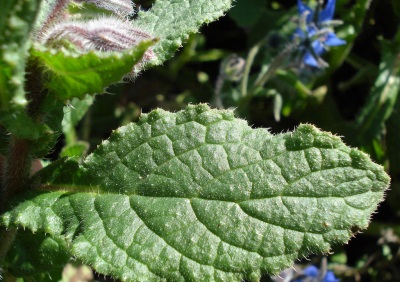
Where does it grow?
This plant is originally from Syria.
The wild form of borage is found in South America, North Africa, Asia Minor, and also in southern Europe.
As a weed, this plant can be seen in vegetable gardens and fields in southwestern Russia.
Peculiarities
- The leaves have a pleasant smell and taste reminiscent of cucumber.
- High nutritional value.
- The scope of borage is very extensive, including medicine and cooking.



Nutritional value and calories
- Calories per 100 grams: 21 kcal.
Nutritional value per 100 gr.:
- Proteins - 1.8 g,
- Fat - 0 g,
- Carbohydrates - 3.06 g.
Protein 34%, carbohydrates 58%, fats 0%.
The main value of flowers lies in essential oils.

Borago contains (daily rate in 100 g):
- vitamin A (88%),
- vitamin C (54%),
- iron (20%),
- calcium (10%).
Chemical composition
in flowers contains essential oils, as well as mucous substances.
in the leaves there are mineral salts (the plant is rich in potassium), tannins, ascorbic acid, saponins, malic acid, carotene, citric acid and mucus, so they are often used in cooking.



Benefit
- Borage leaves contain a significant amount of carotene, tannin and organic acids. They also contain mucous substances, vitamin C, potassium and magnesium.
- The seeds contain a lot of fatty oils.
- Borago is included in the pharmacopeia of many European countries, so this plant is included in some dietary supplements.
- Nutritionists advise people who have digestive problems, vascular diseases, and impaired metabolism to add borage to dishes.
- The flowers contain a significant amount of mucous substances, as well as essential oils.

Harm
- Long-term use of borage can impair liver function.
- Experts warn that borage should be used continuously for no longer than one month.
- Also, do not take borage as an independent medicine - it is better to include this plant in the composition of the medicinal collection.
Oil
Cucumber seeds contain fatty vegetable oils. Due to the significant amount of fatty acids, including essential linoleic and linolenic, as well as the content of vitamins E, A and F, the oil of this plant has a beneficial effect on the skin. It enhances its protective function, promotes moisture retention, increases elasticity.

You can buy such oil, placed in capsules, at a pharmacy.
At home, you can grind the seeds and take a quarter teaspoon three times a day.
The use of borage oil is effective for acne, various types of rashes, eczema, as well as various inflammatory processes.
Fresh Juice
- Cucumber juice is recommended for use in fever, infectious diseases (scarlet fever, smallpox, rubella), urolithiasis, cystitis, inflammation of the kidneys, gallstones, edema.
- Reception of fresh juice helps to reduce the excitability of the National Assembly, eliminate insomnia, fears, depression.
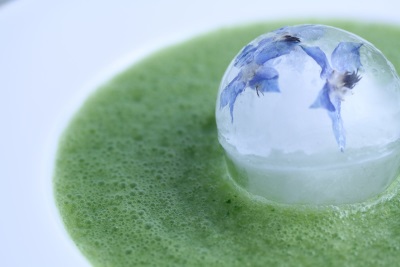
For fresh juice:
- The lower leaves of borage should be washed first with cold water and then with boiling water.
- Pass them through a meat grinder,
- Squeeze and dilute 1 to 1 with whey or water.
- Boil the resulting liquid over low heat for three minutes.
Take fresh borage juice before meals 3-4 times a day, 3 tablespoons.
Application

In cooking
- In Europe, borage is grown as a vegetable because the young leaves of borage have a refreshing, cucumber-like taste that has an onion-like flavor. That is why cucumbers are often replaced with this plant in cold soups, salads, sauces and other dishes.
- Young leaves of borage, plucked before the plant blooms, are added to salads. Seven-lobed leaves are preferable, as they are particularly tender. Later, the leaves become rougher and covered with hairs, but they can also be consumed.
- Collected in autumn, borage roots are added to cheeses, sour cream, cottage cheese, butter. Also, with their help, they create the aroma of syrups, essences, punches, wines, vinegars, tinctures and other drinks.
- Borage is added to minced meat, fried fish or minced meat to give a piquant taste.
- Borago pairs well with other green vegetables such as cabbage or celery.
- The shoots of this plant after sautéing or blanching can be served as a side dish.



Cucumber flowers are also eaten - dried, fresh or candied. They make good decorations for confectionery, drinks or salads.

Cucumber grass is also a good honey plant. Honey is light and tasty.

So that borage leaves do not lose their flavor when served with hot dishes or salads, season the dishes before serving.

You can make refreshing lemonade from borage. To do this, take one handful of fresh leaves of the plant, as well as a handful of lemon balm / mint / parsley leaves. Grind the plants (possible in a blender), adding chopped lemon without skin to them. Pour everything in a few glasses of cold water, add a spoonful of agave syrup, stevia or maple syrup, as well as ice cubes.

For a delicious spring salad chop 100 g of borage leaves, boiled potatoes and 40 g of green onion feathers. Top with sour cream.
In the United States, borage is often used to make mashed soups and, of course, decorate cooked dishes with flowers.

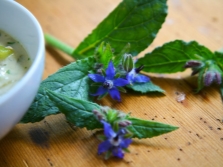

In medicine
For the purpose of therapeutic use, borage is harvested during flowering. The plant is finely chopped and dried under a canopy. Also borage can be frozen.
Properties of borage, which are used in medicine:
- Diuretic, laxative, diaphoretic - in young shoots.
- Soothing, tonic - at the decoction.
- A positive effect on blood vessels, joints, liver, heart, intestines, metabolism - in a fresh plant.
- Lowering the temperature, lowering blood pressure, increasing lactation - in tea (pour 1 teaspoon of flowers or 1 tablespoon of dried stems with 250 ml of boiling water).
- Reducing sweating - infusion (borage and strawberry leaves 1:1, drink instead of tea).
- Healing of burns, abrasions, ulcers, wounds on the skin - at the infusion (pour a handful of dried leaves with 500 ml of boiling water and leave for 15 minutes).

For weight loss
Fresh borage juice also has an effect on excess weight. In order to lose weight, this juice is drunk 2 times a day. It can be consumed on its own or combined with celery juice.
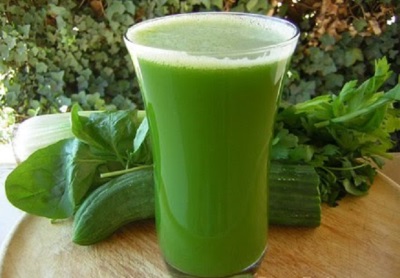
At home
- If you plant borage along with potatoes, it helps to resist Colorado potato beetles.
- From the aerial part of the plant, a dye is obtained that stains woolen fabrics blue.



cultivation
Borage seeds are sown in the ground without preparation in early May to a depth of about 3 cm. The beds are placed every 40-45 cm. If the seedlings are very dense, they should be thinned out, leaving up to 15 plants per meter of beds. For an early harvest, the plant is sown in pots at the end of March, and when 3-4 leaves appear, they are planted under a film. To get a late harvest, borage must be sown in late summer.
For excellent taste, borage needs to be looked after:
- in drought it should be watered,
- around the plants it is necessary to loosen the soil,
- fertilize the soil.
The plant reproduces well by self-sowing - having sown it only once, next year in the spring the seeds that crumble will sprout.
One of the advantages of borage is the absence of disease. Also, borage grass is not interested in pests.

Varieties
- Dwarf
- Vladykinskoye Semko
- Okroshka
- Brook
- April
In summer cottages and farms, it is recommended to grow the Vladykinskoye Semko variety. Its leaves are large and oval, strongly pubescent, and the flowers are large, blue. A strongly pronounced cucumber smell, a strongly branched stem, resistance to low temperatures are the advantages of the Gnome variety.
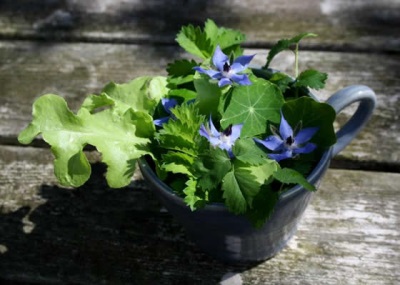
Interesting Facts
Cucumber grass in history:
- Roman soldiers chewed it on campaigns to keep up their courage.
- For the same purpose, the crusaders used wine infused with this plant before the battle.
- Due to its medicinal properties, borage was called the "heart flower" and "the joy of the heart."
- In England during the time of Elizabeth I, borage flowers were added to salads to evoke pleasant thoughts. They also boiled cough syrup and insisted on wine.
- In the late 16th century, borage flower syrup began to be used to treat bad mood and sleepwalking.
You can watch the following video about borage. You will learn a lot about the beneficial properties of borage and its uses.


















I really liked the borage flower frozen in a cube! Very beautiful! We must do so.